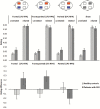Transcranial Direct Current Stimulation Improves Semantic Speech-Gesture Matching in Patients With Schizophrenia Spectrum Disorder
- PMID: 30304518
- PMCID: PMC6483581
- DOI: 10.1093/schbul/sby144
Transcranial Direct Current Stimulation Improves Semantic Speech-Gesture Matching in Patients With Schizophrenia Spectrum Disorder
Abstract
Background: Patients with schizophrenia spectrum disorders (SSD) have severe deficits in speech and gesture processing that contribute considerably to the burden of this disorder. Brain imaging shows left inferior frontal gyrus involvement for impaired processing of co-verbal gestures in patients with schizophrenia. Recently, transcranial direct current stimulation (tDCS) of the left frontal lobe has been shown to modulate processing of co-verbal gestures in healthy subjects. Although tDCS has been used to reduce symptoms of patients with SSD, the effects of tDCS on gesture processing deficits remain hitherto unexplored.
Objective: Here we tested the hypothesis that inhibitory cathodal tDCS of the left frontal lobe decreases pathological dysfunction and improves semantic processing of co-verbal gestures in patients with SSD.
Methods: We measured ratings and reaction times in a speech-gesture semantic relatedness assessment task during application of frontal, frontoparietal, parietal, and sham tDCS to 20 patients with SSD and 29 healthy controls.
Results: We found a specific effect of tDCS on speech-gesture relatedness ratings of patients. Frontal compared to parietal and sham stimulation significantly improved the differentiation between related and unrelated gestures. Placement of the second electrode (right frontal vs parietal) did not affect the effect of left frontal stimulation, which reduced the preexisting difference between patients and healthy controls.
Conclusion: Here we show that left frontal tDCS can improve semantic co-verbal gesture processing in patients with SSD. tDCS could be a viable tool to normalize processing in the left frontal lobe and facilitate direct social communicative functioning in patients with SSD.
Keywords: co-verbal gestures; gesture processing; left frontal lobe; left inferior frontal gyrus (IFG); tDCS.
© The Author(s) 2018. Published by Oxford University Press on behalf of the Maryland Psychiatric Research Center.
Figures




Similar articles
-
Neural Basis of Speech-Gesture Mismatch Detection in Schizophrenia Spectrum Disorders.Schizophr Bull. 2021 Oct 21;47(6):1761-1771. doi: 10.1093/schbul/sbab059. Schizophr Bull. 2021. PMID: 34050672 Free PMC article.
-
Modulating the assessment of semantic speech-gesture relatedness via transcranial direct current stimulation of the left frontal cortex.Brain Stimul. 2017 Mar-Apr;10(2):223-230. doi: 10.1016/j.brs.2016.10.012. Epub 2016 Oct 25. Brain Stimul. 2017. PMID: 27815051
-
Modulation of Gestural-verbal Semantic Integration by tDCS.Brain Stimul. 2015 May-Jun;8(3):493-8. doi: 10.1016/j.brs.2014.12.001. Epub 2014 Dec 11. Brain Stimul. 2015. PMID: 25558040
-
Transcranial Direct Current Stimulation Effects on Semantic Processing in Healthy Individuals.Brain Stimul. 2016 Sep-Oct;9(5):682-691. doi: 10.1016/j.brs.2016.05.003. Epub 2016 May 12. Brain Stimul. 2016. PMID: 27288226 Review.
-
Effects and potential mechanisms of transcranial direct current stimulation (tDCS) on auditory hallucinations: A meta-analysis.Psychiatry Res. 2019 Mar;273:343-349. doi: 10.1016/j.psychres.2019.01.059. Epub 2019 Jan 15. Psychiatry Res. 2019. PMID: 30682555 Review.
Cited by
-
Neural Basis of Speech-Gesture Mismatch Detection in Schizophrenia Spectrum Disorders.Schizophr Bull. 2021 Oct 21;47(6):1761-1771. doi: 10.1093/schbul/sbab059. Schizophr Bull. 2021. PMID: 34050672 Free PMC article.
-
Single Session Transcranial Magnetic Stimulation Ameliorates Hand Gesture Deficits in Schizophrenia.Schizophr Bull. 2020 Feb 26;46(2):286-293. doi: 10.1093/schbul/sbz078. Schizophr Bull. 2020. PMID: 31634401 Free PMC article. Clinical Trial.
-
A Developmental Perspective on Early and Current Motor Abnormalities and Psychotic-Like Symptoms.Schizophr Bull. 2025 Mar 14;51(2):522-530. doi: 10.1093/schbul/sbae062. Schizophr Bull. 2025. PMID: 38728386 Free PMC article.
-
Improving causality perception judgments in schizophrenia spectrum disorder via transcranial direct current stimulation.J Psychiatry Neurosci. 2023 Jul 4;48(4):E245-E254. doi: 10.1503/jpn.220184. Print 2023 Jul-Aug. J Psychiatry Neurosci. 2023. PMID: 37402578 Free PMC article.
-
A pilot study to investigate the efficacy and tolerability of lesion network guided transcranial electrical stimulation in outpatients with psychosis spectrum illness.Asian J Psychiatr. 2023 Oct;88:103750. doi: 10.1016/j.ajp.2023.103750. Epub 2023 Aug 22. Asian J Psychiatr. 2023. PMID: 37633159 Free PMC article.
References
-
- Goldin-Meadow S. The role of gesture in communication and thinking. Trends Cogn Sci. 1999;3(11):419–429. - PubMed
-
- Kelly SD, Barr DJ, Church RB, Lynch K. Offering a hand to pragmatic understanding: the role of speech and gesture in comprehension and memory. J Mem Lang. 1999;40:577–592.
-
- Kelly SD, Church RB. A comparison between children’s and adults’ ability to detect conceptual information conveyed through representational gestures. Child Dev. 1998;69(1):85–93. - PubMed
-
- Valenzeno L, Alibali MW, Klatzky R. Teachers’ gestures facilitate students’ learning: a lesson in symmetry. Contemp Educl Psychol. 2003;28(2):187–204.
Publication types
MeSH terms
LinkOut - more resources
Full Text Sources
Medical

